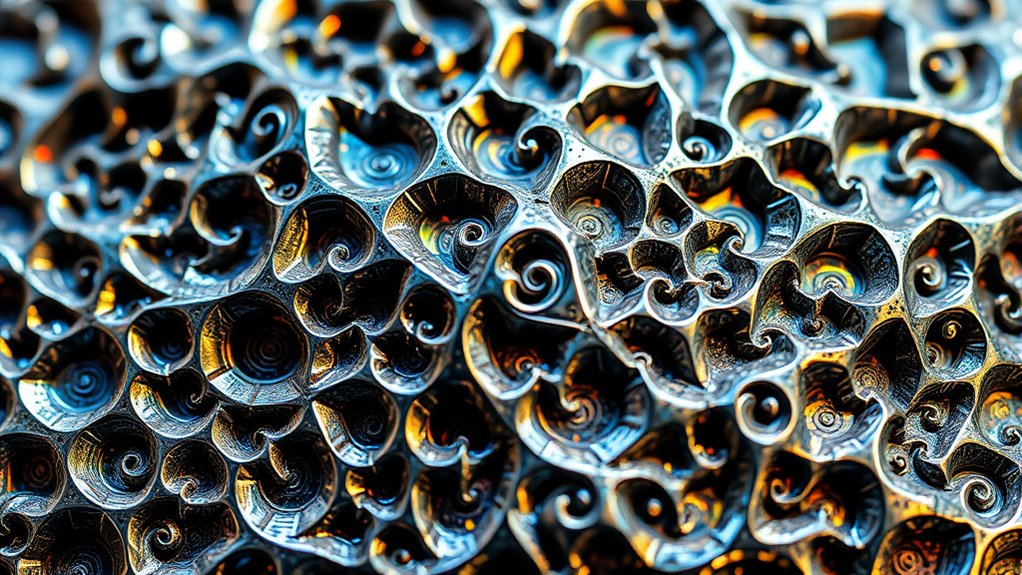Fractal materials use complex, self-similar patterns to improve strength, durability, and efficiency. By designing structures with fractal micro- and nano-scale features, you can enhance properties like toughness, flexibility, and conductivity. These intricate patterns help distribute stress and optimize pathways for transport, turning apparent chaos into resilient architecture. As you explore further, you’ll uncover how fractal principles enable innovative materials that push current limits of performance and stability.
Key Takeaways
- Fractal microstructures distribute stress efficiently, enhancing overall mechanical strength and fracture resistance.
- Designing fractal architectures creates complex load paths, improving material durability under various forces.
- Fractal dimensions influence pore networks, enabling lightweight yet strong materials through optimized internal structures.
- Incorporating fractal patterns allows for scalable manufacturing of resilient materials with tailored properties.
- Utilizing chaos-inspired fractal designs transforms irregularity into strength, maximizing material performance.

Have you ever wondered how complex material structures influence their properties? The answer lies in the fascinating world of fractals, geometric shapes that display intricate detail at every scale. Unlike traditional shapes with integer dimensions—lines being 1D, planes 2D, and solids 3D—fractals have fractional dimensions that reveal their complex, space-filling nature. These shapes are self-similar, meaning their patterns repeat at different scales, either exactly or approximately. Think of the Mandelbrot set or the Menger sponge; their repeating patterns demonstrate how fractals embody complexity beyond simple Euclidean geometry. This fractal geometry extends the conventional understanding of shape, providing a way to model irregular, fragmented structures that are common in nature and materials alike.
When you examine the microstructure of materials, you’ll find many display fractal patterns. Using advanced techniques like scanning electron microscopy (SEM) and transmission electron microscopy (TEM), scientists can analyze these microstructures in detail. Fractal analysis quantifies the irregularity and organization within materials by calculating their fractal dimension. This numerical measure reflects how rough or space-filling a microstructure is. For example, a porous material with a high fractal dimension indicates a highly complex pore network, which directly affects its physical properties. By understanding these fractal characteristics, you can predict how a material will behave under different conditions, bridging the gap between microscopic structure and macroscopic performance. Additionally, the fractal dimension can be used to compare different materials or track changes in microstructure during processes like fatigue or corrosion.
The impact of fractal geometry on material properties is profound. The fractal dimension of pores influences how easily fluids can move through a material, affecting permeability. Typically, permeability scales with the cube of the fractal dimension, meaning small changes can lead to significant differences in flow. Similarly, higher fractal dimensions often correlate with increased mechanical strength because the self-similar patterns distribute loads more evenly, enhancing durability. Conductivity, whether electrical or thermal, can also be linked to the complexity of fractal networks within materials. For instance, carbon nanotube composites with fractal-like networks exhibit improved conductivity due to their intricate pathways. Essentially, by manipulating fractal structures, you can engineer materials with optimized strength, lightweight properties, and efficient transport pathways.
In advanced materials, fractal patterns aren’t just theoretical—they’re practical tools. Carbon nanotube composites demonstrate how fractal networks boost electrical performance. Quantum materials like neodymium nickel oxide show fractal magnetic domains that influence their electronic and magnetic properties. Fractal microstructures in ceramics and alloys affect toughness, porosity, and fracture resistance. Incorporating fractal metrics into material design allows engineers to enhance interface strength, damage tolerance, and other critical features. These fractal structures at the nanoscale contribute to emergent quantum effects and novel physical properties, opening new avenues for innovation. By harnessing the principles of fractal geometry, you can turn chaos into a source of strength, creating materials that are both resilient and efficient. This approach also enables the development of scalable manufacturing processes for complex fractal architectures, expanding their practical application across industries. Understanding the fundamental nature of fractals helps in designing materials with tailored properties for specific applications.
Frequently Asked Questions
How Do Fractal Patterns Influence Material Durability Over Time?
You can see that fractal patterns impact material durability over time by shaping microstructures and pore networks. These patterns influence how cracks develop, how pores grow, and how microdamage accumulates. As fractal dimensions change, they indicate microstructural evolution, which affects strength and resistance to environmental stress. By monitoring these fractal characteristics, you gain insights into long-term durability, allowing you to predict failures and optimize materials for better longevity.
Can Fractal Materials Be Recycled or Reused Effectively?
Did you know that some products made from recycled plastics now use 100% reclaimed resin? You can see that fractal materials can be recycled effectively through chemical processes like depolymerization, which recover monomers. While the fractal microstructure may change, innovative monitoring techniques help optimize recycling. By designing fractal materials with recyclability in mind, you can guarantee they retain their properties and support a sustainable, circular economy.
What Industries Are Most Likely to Adopt Fractal Material Innovations?
You’ll find that industries like electronics, energy storage, healthcare, and aerospace are most enthusiastic to adopt fractal material innovations. These sectors benefit from enhanced performance, durability, and efficiency that fractal structures provide. By integrating fractal designs, you can develop smarter sensors, higher-capacity batteries, biocompatible implants, and stronger, lighter composites—ultimately leading to more advanced, sustainable, and reliable products across these fields.
Are There Any Health Risks Associated With Fractal Material Manufacturing?
You should know that manufacturing fractal materials poses health risks like electrical shock, especially from high-voltage fractal burning equipment, which lacks safety certification. Additionally, dust and chemical exposure from materials like epoxy and fiberglass can cause respiratory, skin, and eye issues. To stay safe, always wear PPE, use certified equipment, ensure proper ventilation, and follow safety guidelines to mitigate these hazards.
How Does the Cost of Fractal Materials Compare to Traditional Materials?
Imagine building a fortress with materials that cost more upfront but save you money in the long run. Fractal materials typically have higher initial costs due to advanced manufacturing, but they pay off through lower maintenance, reduced energy use, and faster installation. Traditional materials, while cheaper initially, often incur higher long-term expenses. So, your choice depends on balancing initial investment versus ongoing savings and durability.
Conclusion
By harnessing the power of fractal geometry, you access a new domain of material strength, resilience, and adaptability. You design with chaos, transform complexity into utility, and turn disorder into order. You embrace the intricate patterns that nature offers, challenge traditional limits, and push the boundaries of engineering. In fractal materials, you find innovation through repetition, strength through complexity, and future through chaos—showing that in every disorder lies the potential for extraordinary strength.










